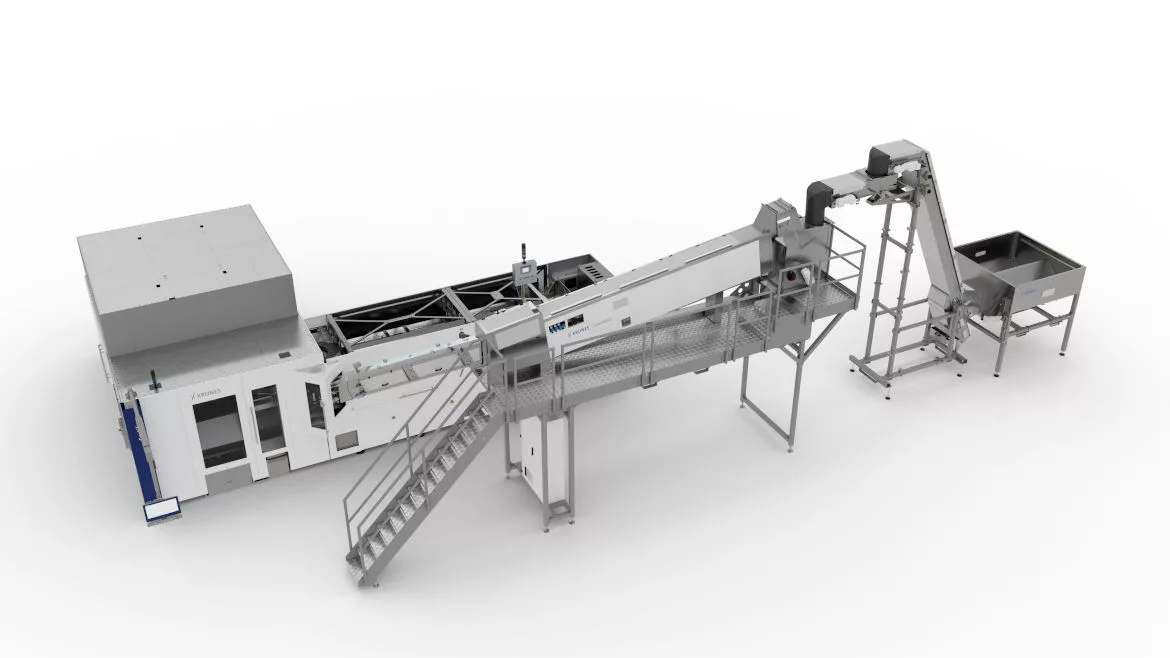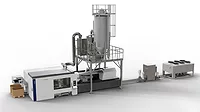Plastic bottle manufacturers help beverage operations tackle sustainability goals
Changeover efficacy vital to accommodate new products, packaging

Image courtesy of Krones Inc.
Sustainability continues to be one of the top concerns for consumers. Earlier this year, PwC released its “2024 Voice of the Consumer Survey,” which reported that 46% of consumers indicated buying more sustainable products as a way to reduce their impact on the environment. The survey also found consumers’ sustainability interest extends to producers’ sustainability practices, including 38% interested in eco-friendly packaging and 40% interested in production and recycling methods by producers.
Given this high interest from consumers toward sustainability, today’s plastic bottle manufacturers are taking the steps to ensure their business aligns with what consumers are looking for.
“Bottling companies are seeking to reduce the environmental impact of their packages, both on the material and the energy consumption side,” says Sebastian Wenderdel, business development director of PET at KHS USA Inc., Waukesha, Wis.
In terms of production sustainability, Wenderdel highlights how plastic bottle manufacturers are addressing energy usage throughout the production process.
“With energy prices on the rise everywhere, bottlers are seeking possibilities to increase their energy efficiency in the complete production line,” he says. “With the stretch blow molder being the largest energy consumer in a PET bottle production line, saving energy there is a logical step. A lot of machines from the late ‘90s and early 2000s are being replaced now, savings in air and re-heat energy can easily reach 50%. But also upgrades to existing machines can help to reduce energy consumptions, high-pressure air recycling conversions and oven upgrades become more and more popular.”
Today’s equipment has a higher throughput to enable more production with a smaller footprint, and is much more efficient in terms of air and energy consumption.
Bryan Lee, blowmolding technology sales for North America at Krones Inc., Franklin, Wis., also highlights how today’s equipment is designed to support a more sustainable production process.
“Today’s equipment has a higher throughput to enable more production with a smaller footprint, and is much more efficient in terms of air and energy consumption,” Lee says.
And when it comes to the finished product, a growing interest in post-consumer-recyclate (PCR) has taken shape, however, KHS’s Wenderdel notes that companies have struggled with goals surrounding this material because of its availability.
“The material availability is growing, but still scarce and hence costs are going up,” he says. “Blow molders [do not] usually have a big problem in handling higher PCR contents in the re-heat process of the preforms, but quality control is key here.
“For today’s high-speed productions, we are implementing new inspection and automation tools in the control of our blow molders to support the customers in handling sudden changes in preform quality and colors during a production run,” Wenderdel continues. “Operators would not be able to make adjustments before seeing a bad bottle blown, so we designed a system to adaptively adjust the re-heat process parameters already before the blowing process.”
Krones’ Lee highlights that the development of lighter weight bottles, recycled PET (rPET) and biodegradable materials have become a bigger factor when designing today’s plastic bottle manufacturing equipment.
“An increased focus on Circular Economy means that we have to adapt to, and also help develop, new products like tethered caps and label-less bottles, so that the recycling process can become more efficient and effective,” he says.
Lee highlights how Krones is approaching its equipment to support the sustainability needs of today.
“Krones looks at sustainability in many ways,” Lee says. “Recycled material can have more defects than virgin plastic, so you need to have an inspection system that can detect impurities in both preforms and bottles. The machines should be flexible enough to produce even with varying quality of raw materials as well as optimized for air and energy efficiency. And from an equipment manufacturing standpoint, Krones is investing in renewable energy as we strive to lower our own carbon footprint.”
KHS’s Wenderdel also highlights how lightweighting has impacted the production of plastic bottles in order to maintain the bottles integrity.
“Further lightweighting of PET bottles implies that old, off-site production setups no longer work for them, because lighter empty bottles can get dented or crashed during the transport, storage and feeding into the filling line,” he says. “Most bottlers therefore opt for self-manufacturing nowadays and they mostly do so on ‘blocked’ setups, i.e., the blow molders directly linked to the filler or even the labeler and the filler, by means of transfer stars. Like this, empty bottles also don’t get stressed in an air conveying system and are always safely handled by the neck before being filled and capped.”
Flexible approach
Sustainable operations is just one of the many factors that beverage-makers are accounting for. Experts note that SKU proliferation continues to impact the manufacturing world.
Because of this, flexibility to support changeovers for not just product but also varying packaging formats is a necessity for beverage manufacturers.
“Customers want to have the ability to run multiple formats on the same line, so the machines have to be capable of not only fast, but also repeatable, changeovers,” Krones’ Lee says. “Quick-change tooling and robotics, and digital products like our LineXpress System have helped streamline the process to increase changeover speed and reliability.

KHS’s Wenderdel also highlights the importance of seamless changeovers for operations.
“Customers expect quick and flawless changeovers from one SKU to the next, with minimum downtimes and zero errors throughout the whole manufacturing line,” Wenderdel says. “At KHS, we have designed numerous quick-change solutions in our equipment, for the stretch blow molders customers can nowadays get these options for both simple bottle changes and the more complex bottle neck changes. Downtimes can be reduced drastically with these tools, and we have possibilities to do these changeovers manually, guided or automatically with the assistance of robots.”
Wenderdel adds that another impact on equipment in terms of SKU proliferation has been the market’s expectation regarding new format parts, such as blow moulds.
“With our Bottles&Shapes program, we assist customers with a holistic approach to introduce new formats into their existing filling and packaging lines,” Wenderdel says. “We always take into account all aspects to guarantee a good performance of new bottles in the line and beyond, on their way to the end consumer, and make sure that once the new moulds and format parts arrive on site our customers can have a plug-and-play startup.
“Communication is key in this undertaking and our colleagues in this are, both in the local markets and at our PET competence center in Hamburg, have years of knowledge and experience to help the customer with the best-in-class solution, at competitive pricing and quick lead times,” he continues.
Next steps
As original equipment manufacturers adapt equipment to support the needs of today’s beverage manufacturers, suppliers also are exploring ways that artificial intelligence (AI) could play a greater role going forward.
Krones’ Lee explains that AI is available when it comes to collection, but can be implemented in other areas.
“AI is already being used on the collection side of the recycling industry, helping to identify and sort different types of materials,” he says. “It can be used in the bottle design process, to quickly produce a family of bottles or to make adjustments to current packages when lightweighting or changes in rPET levels are needed. Another use can be as a predictive and preventive maintenance tool, as it can monitor anomalies and their causes, and alert personnel as necessary.
“Logistics planning and resource management can be streamlined by AI, helping to coordinate changeovers and deliver raw materials to the line as needed,” Lee continues. “And it can even be a machine operator, making adjustments to heating and blowing parameters when there are environmental or material quality changes.”
KHS’s Wenderdel notes that AI has become a buzzword throughout the industry. However, advancements even outside the realm of AI are playing a role in the future of plastic bottle manufacturing.
“In blow molding, automated process control systems that dynamically adjust to varying operating conditions have been around forever,” Wenderdel says. “We introduced a new technology recently that based on varying color levels in rPET preform charges regulates the intensity of the NIR lamps in the oven, before the preforms actually enter the oven. With bottles at the limits of lightweighting today and rPET contents on the rise (but not always so its quality), process windows to get a good bottle out of the high-speed blow molders become smaller and smaller.
“Here, an automated system is of great help for the operators to keep their bottles in spec, as they would physically not be able to adjust the process by themselves in time before bringing out at least some bad bottles,” he continues. “Is such a system with self-learning features on board now a sort of artificial intelligence? Maybe yes, naming it AI or not (we don’t) from my point of view does not improve or decrease its benefit for our customers.”
Looking for a reprint of this article?
From high-res PDFs to custom plaques, order your copy today!






